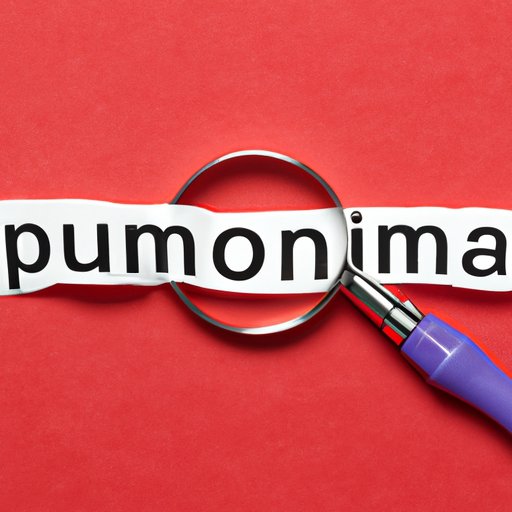I. Introduction
Pneumonia is a serious respiratory illness that affects millions of people every year. It can range from mild to severe and cause complications that may even lead to hospitalization. Recognizing the symptoms and seeking medical attention promptly is crucial in preventing serious health issues. This article will provide key information to help you recognize the signs and symptoms of pneumonia, differentiate it from the common cold and flu, identify risk factors, and outline prevention and treatment options.
II. Symptoms and signs of pneumonia
Common symptoms of pneumonia include a persistent cough, fever, difficulty breathing, chest pain, fatigue, and a general feeling of being unwell. Physical signs may include a crackling sound in the chest, low oxygen levels, and abnormally fast breathing. If you suspect you may have pneumonia, it is important to seek medical attention immediately. Your doctor will likely perform tests such as a chest X-ray or blood test to confirm the diagnosis.
III. Differentiating pneumonia from the common cold and flu
While many symptoms of the common cold and flu overlap with those of pneumonia, some key factors can help differentiate them. Chest pain, high fever, and breathing difficulties are signs that could indicate pneumonia. Not recognizing these symptoms may lead to complications such as respiratory failure, sepsis, and lung abscesses.
IV. Risk factors for contracting pneumonia
People at higher risk of developing pneumonia include the elderly, smokers, and those with weakened immune systems due to chronic illness. Recent illnesses such as the common cold or flu also increase the risk, as well as exposure to environmental factors such as air pollution and tobacco smoke. Reducing risk factors can involve actions such as getting vaccinated, quitting smoking, and practicing regular hand hygiene.
V. Treatment for pneumonia
Treatment for pneumonia typically involves antibiotics or antiviral medications depending on the cause of the infection. Over-the-counter medications such as cough suppressants and pain relievers can provide relief from symptoms. It is also important to rest and stay hydrated while allowing time for the body to recover. For severe cases of pneumonia, hospitalization may be necessary.
VI. Prevention strategies for pneumonia
Preventing pneumonia begins with taking care of your overall health. Regular exercise, a diet rich in nutrients, and getting enough sleep can help boost your immune system and reduce risk factors. Other prevention strategies include practicing good hand hygiene, staying home when sick, avoiding close contact with others who are sick, and getting vaccinated. Vaccination is considered the most effective prevention strategy for pneumonia, especially for those at high risk.
VII. Conclusion
Pneumonia is a serious respiratory illness that requires prompt medical attention. By recognizing the signs and symptoms, differentiating it from the common cold and flu, identifying risk factors, and taking preventative measures, you can protect your health and reduce the risk of complications. It is important to seek medical attention if you suspect you may have pneumonia. With proper care, most people can fully recover from pneumonia and avoid serious health risks.
